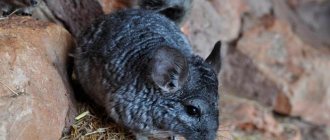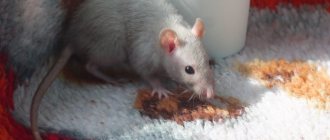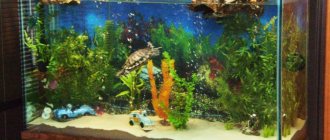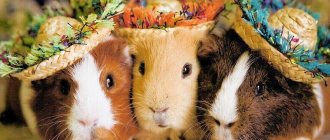Black rat
Black Rat Habitat
Baby rats
The black rat prefers areas near rivers and lakes, but is not attached to it. It swims poorly, does not dig holes in the ground, does not try to get into human habitation, is found in forests, fields, edges, and is less common in cities. The spread of this type of rat is mainly due to humans. The black rat is a constant companion of sea vessels and ships.
Appearance
In appearance, the rodent of the mouse family is somewhat smaller than its relative, the gray pasyuk:
- body length does not exceed 22 cm;
- the tail is always longer - about 28 cm;
- body weight from 130 g to 300 g;
- the ears are small, but wide at the base, round, more like a mouse’s;
- the muzzle is elongated, round eyes are clearly visible.
The coat consists of an undercoat and long, hard outer hairs. The color is black with a greenish tint, but it can also be dark gray, like Pasyuk. On the sides the coat is always lighter – dirty gray in color. The tail is long, scaly, and completely covered with long black hairs. There is a small brush at the tip.
The color of the black rat differs depending on the region where it lives. Southern representatives are always lighter. Northern rats are black with a brilliant green tint.
Interesting!
The description of a black rat is always compared to a pasyuk. These are the main competitors who do not get along well in the same territory. Gray relatives are superior in numbers, size, predatory habits, and ability to quickly adapt. But black rats are more resistant to poisons.
A photo of a black rat is presented below; you can clearly see the animal in all its glory.
Black rat
A little biology
Black rats are a species of mammal of the rodent order, the Latin name of the species is Rattus rattus.
The body length is 16-22cm. The weight of this type of rodent ranges from 100 to 350 grams. The tail is longer than the animal's body. Males are much larger in size than females. The color of a black rat can be of two types: 1) Close to black. Individual hairs have a greenish-metallic tint. The fur becomes lighter on the sides, and on the belly it becomes ashy or dirty gray. 2). Looks like a pasyuk, lighter and yellower. The abdomen has a white or yellowish tint. The black rat's muzzle is narrow, it has large ear shells, a well-formed neck, and a long, flexible tail. Basically, black rats are nocturnal animals, but the daily rhythm of their activity depends on the nature of human activity in the rooms where they live or get food. Rats are active primarily during those hours of the day when they are less bothered by the presence of people. The black rat's diet is varied. It eats grain, bread, various vegetables, and meat products, but unlike the gray rat, it prefers plant foods, and animal food is of relatively little importance to it, as a result of which its teeth, jaws and corresponding muscles are less developed than those of the gray rat. In nature, as a rule, it does not dig burrows, but lives in hollows or makes spherical nests from branches in trees, similar to the nests of magpies. It climbs very well, in nature it often leads a semi-arboreal lifestyle, but rarely swims. Like gray rats, black rats live in groups that include adults of both sexes and young animals. Hierarchical relationships are established within the group with dominance of one male. Two or three females usually dominate the rest of the group with the exception of the eldest male. Black rats are less aggressive than pasyuki; females are more aggressive than males. In case of danger, they try to hide from their pursuer and only, when caught, use their teeth.
Already a 3-4 month old black rat is capable of reproduction. Unlike the gray rat, it reproduces less intensively, although under favorable conditions it can bear offspring in winter. During the year there are usually 2-3 litters of 6-7 rats. The duration of pregnancy is 21-22 days. Newly born rat pups are completely naked, but they grow very quickly, become covered with hair and become able to independently obtain food. In the wild, life expectancy rarely exceeds 2 years. In captivity, a black rat with careful care can live up to 5-6 years.
Location
Where the black rat lives is a very interesting question. The favorite habitat for the rodent is sea vessels. Rats live side by side with humans and eat identical food. They spread around the globe thanks to water transport.
The black rat is less inventive than its relative the Pasyuk. Content with little. Settles near reservoirs and rivers. But it is less attached to water than the gray one. Does not build nests in the ground, avoids water, but if necessary, swims quite a long distance. It does not dive because fish, fry, and amphibians are of little interest to it.
Willingly settles in the forest, fields, and edges. The lifestyle is more reminiscent of voles. In urban areas, it prefers sewers, abandoned buildings, garages, garbage cans, and entrances. Can live in a person’s house, occupying the upper floors or attic.
What does it look like
The black rat is small in size. The length of her body does not exceed 22 centimeters, and her weight ranges from 130 to 400 grams. The pest's tail is longer than the body and grows up to 29 cm. It is thickly covered with hard hair. The color is the same on both top and bottom.
Interesting!
This type of rat is the smallest and most agile.
The rodent's muzzle is elongated with black eyes. The ears are round, larger in size than those of the Pasyuk, but smaller than those of a mouse. They are thin, pink in color and lightly covered with fur.
There are two types of black rat color:
- Dark, close to black. Guard hairs with a metallic sheen. The abdomen is ashen or gray.
- The color is like the Pasyuk's, but a little lighter. The belly is white or light yellow.
The animal's legs are short. The hind limbs are larger than the forelimbs. The fingers are tenacious and have sharp claws. Thanks to them, the rat masterfully moves on any surface.
Photos of the black rat demonstrate how very different it is from the Pasyuk.
Black rat
Lifestyle
Habitat of the black rat
The black rat builds nests in old hollows and trees. For construction he uses twigs, sticks, and moss. The rodent's house looks more like a magpie's nest. Often rodents simply occupy a ready-made nest, eating the legal inhabitants.
Black rats spend the day in the nest, hiding from the sun's rays. They intensify their activity after dark. They behave carefully. Because there are plenty of natural enemies - dogs, cats, hedgehogs, birds, wolves, foxes.
The black rat part can be seen on the tree. The rodent climbs well on horizontal and vertical surfaces. If necessary, climbs to the very top.
On a note!
In the old days they lived in a man's house under a thatched roof. Modern rodents prefer attics. They share territory with pasyuki. The first live above, the second below under the floor.
The average lifespan of an animal in the wild is 1 year. As a pet it lives up to 4 years.
Duration and lifestyle
Black animals that live in freedom love to build houses in the form of nests in trees. It happens that they occupy a ready-made dwelling, and its inhabitants are first destroyed. Animals are excellent tree climbers and can easily climb vertical trunks, but they do this extremely rarely.
Wild rodents do not like sunlight; daylight is a time of rest for them. Animals are very careful, because at any moment they can become prey to predators. The instinct of anxiety is also transmitted to domestic rats. Animals are always on the alert, they cannot be taken by surprise.
In wild communities of black rats there is always a leader (male) and 4-6 assistants (females). If animals are brought to cool latitudes, they stop reproducing until it gets warmer. It is for this reason that gray pasyuki are replacing black rats, despite the similarities in appearance of both species.
Domestic rodents remain social animals. Experts advise, if possible, to purchase them in groups, which consist of individuals of the same age of the same sex. This helps to avoid rapid reproduction of pets, as well as conflicts between them.
Domestic rats are very clean. They are easy to care for, but you will need to purchase:
- cell;
- filler;
- feed.
Timely cleaning of the animal's home eliminates the possibility of unpleasant odors. The rat independently chooses the place in the cage where the toilet will be. There you need to place a small tray with filler. In the wild, black rats rarely live beyond 2 years. Pets with good care can live 3.5–4 years.
Interesting! If the little rats at first vigorously “sort things out,” you shouldn’t be surprised. When a natural hierarchy is established, the animals will calm down, live as a family and play together.
Nutrition
The black rat can hardly be called a predator. The rodent prefers plant foods, plant seeds, grains, vegetables, and fruits. Protein foods make up a small part of the diet. Occasionally eats beetles, worms, and may covet bird eggs.
Interesting!
A rodent eats 15 g of food and 15 ml of water per day. Hunger is difficult to bear. In the absence of food, it can live no more than 2 weeks. If there is a shortage of water, it dies within a week.
Baby rats
Living conditions for domestic rodents
Rats are unpleasant and harmful animals. These rodents bring many diseases to people, as well as many other harms. They damage furniture, electrical equipment, and chew electrical wires. But some people keep decorative rodents in their home. They are distinguished by their flexible disposition and affection for people.
In order for your beloved pet to live to old age, he needs to create good living conditions, provide a balanced diet, and provide the necessary medical care. You should definitely include whole grains in your diet. It could be wheat or rye, corn or millet. He will not give up rice and buckwheat, oats and barley. The grain portion of the diet should make up approximately 80% of the total nutrition. The remaining 20% consists of greens and vegetables. You can give carrots with cucumbers, parsley, dill, pumpkin. Water must be in the cage at all times. The lifespan of rats can be somewhat extended if they are occasionally fed boiled chicken, rabbit, and turkey.
These animals do not require special care. The downside is the very short lifespan of rats
You can give them offal, hard-boiled chicken eggs. Small quantities of nuts will not damage them. These are hazelnuts, almonds, cashews and peanuts. They also love fruits in the form of bananas, apples, dates and grapes.
Medical care for rodents is provided by a ratologist. He is even able to perform some life-saving operations on these animals. But not every city has such a specialist. Therefore, it will be good to find a veterinarian who can provide first aid to your pets.
Animals need a quality cage in which to live. This house needs to be equipped with ladders and hammocks. The bottom should be covered with corn or paper filler. Wood chips are not suitable for this. They contain essential oils that destroy lung and liver cells. This shortens the already short lifespan of animals.
The rats' housing should be equipped with everything that preserves the pets' mobility. Due to lack of exercise, they may experience heart disease and seizures.
How many years rats live depends on heredity. It is better to take little rat pups from breeders who have healthy rats. Their rats reproduce according to a certain plan. In a nursery, a female produces only 2 offspring in her entire life. In stores you can buy offspring from sick parents whose health no one has ever monitored. Rats should not live alone in a cage. But males are placed with females only for the sake of planned mating.
These animals are distributed all over the world
The life of rats can be shortened due to the fault of their owners. The death of animals usually occurs due to collisions with cats and dogs, their eating of insulation of electrical wires and some plants. Deadly plants that pet rats should not have access to:
- spurge;
- laurel;
- nightshade;
- rhododendron;
- ivy;
- Kalanchoe;
- azalea;
- amaryllis;
- fern;
- geranium;
- aloe;
- hyacinth;
- cyclamen;
- mistletoe;
- myrtle;
- tulip;
- dieffenbachia;
- narcissus;
- carnation;
- lily of the valley.
- the pet becomes apathetic and eats less;
- sneezes and has difficulty breathing, wheezing is heard in the lungs;
- the rat scratches itself a lot;
- discharge is visible from the nose and eyes;
- bald spots appear on the coat;
- Coordination of movements in rats is impaired.
If you comply with all the conditions listed above, you can slightly extend the life of your pets.
There are also special breeds of domestic rodents bred artificially. These are sphinxes. Through the process of numerous mutations, a specimen with soft skin without hair was developed. Gradually the breed spread. She needs special care and additional heating at home. Animals love to sit in human hands.
White rats are very attached to humans. They have red eyes and curly fur. Other breeds—Dumbo, Rex, and Satin—have dark-colored coats. They all live about 1.5 years. Their death occurs as a result of diseases. Their signs:
If these signs occur, your pet should be taken to the veterinarian.
Baby black rats
They are born naked, blind, deaf, with undeveloped limbs. But they have an excellent appetite, and significant physical transformations occur every day:
- within a week they become overgrown with fluff;
- after two - hearing appears, eyes open;
- within three weeks, the formation of the limbs and skeleton is completed, and the pups crawl out of the nest.
After a month, the cubs of black rats become independent, eating food typical for adults. They are expelled from the nest, but continue to live in the same colony. The female becomes sexually mature at 6 months.
Intrafamily relations
Rodents live in colonies, each with several hundred representatives. It is led by a male and several dominant females. Young females gain experience from older ones. They help raise children. Several females give birth to offspring in one nest. They feed together.
Misunderstandings often break out between males over the right to own a female, over food, and for other reasons. The defeated male tries to stay away from the winner. Each family is assigned an area of about 2.5 sq.m.
Interesting!
Cannibalism occurs in black rats, but much less frequently than in gray pasyuki. The sailors had one barbaric method of fighting rodents. Several rats were placed in a barrel and starved to death. They began to eat each other, the strongest representative remained. The cannibal beast was released. He hunted his relatives, gradually eating one after another.
Fighting methods
Relocation closer to a person’s home occurs when unfavorable conditions occur - lack of food, premature cold snap, forest fires.
- In gardens, trees are tied with belts to prevent rats, and glue or resin is applied.
- For destruction, traps and traps are placed on the summer cottage.
- Chemicals are used on the territory of the house - poisonous baits, powders, dusts, and traps are built.
- If the premises are severely infested, specialists are called in.
Black rats are not characterized by seasonal population fluctuations. There are no widespread outbreaks of infection observed. It is advisable to use repellent methods to control pests. They use herbs, substances with a pungent odor, and repellent devices.











